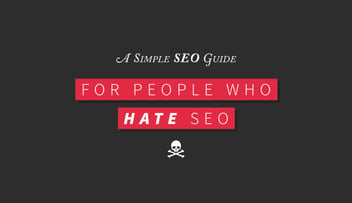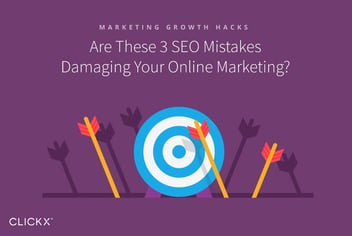Why Old School SEO is Dead (And What You Should Do Instead)

Search Engine Optimization (SEO) has been in a constant state of evolution since its inception. What works now may not work tomorrow, and many old school tactics that once brought traffic now have the opposite effect.
Yet there are still many so-called ‘SEO companies’ out there engaging in bad practices like social bookmarking, spamming and marketing with ‘spun articles’. Fortunately, these guys are gradually going extinct, because what worked in 2010 just doesn’t work anymore. However, they do still exist.
In this post, I am going to focus on what drives high traffic to websites after the demise of old school Search Engine Optimization. I will also highlight the practices that need to be abandoned and the new behaviors that need to be embraced. Keep reading to find out more!
The Game Changer
[Tweet “Google has all but made traditional SEO practices extinct.”]
Last summer’s Penguin update changed common SEO practices, such as excessive link building. The update specifically targeted links that were built for the sole purpose of enhancing rank without adding any real value.
Furthermore, ongoing developments at Google suggest that the company is starting to devalue SEO activities. Lately, Google has been focusing on loading speed, programming, web design and conversion optimization.
So before we move onto exploring what you should be doing, let’s touch upon what you shouldn’t be doing.
More Links Does Not Necessarily Lead to Higher Rankings
These days, having loads of links on a page can get you into trouble with the likes of Google.
Conversely, the ranking of any given page will depend far more on the quality of the backlinks to that page. ‘High quality’ backlinks are weighted more heavily than a greater quantity of ‘poor quality’ links, and the relevancy of links can even trump their quality (which is the result of Google’s Penguin algorithm update).
This has changed the landscape for automated link building programs and link schemes. These old school practices have always violated Google’s webmaster guidelines, but Google is getting ever more powerful in being able to effectively enforce the terms of their guidelines.
More Content Doesn’t Necessarily Generate More Traffic
Just because your website is jam-packed with a huge volume of content doesn’t mean that you will benefit from a higher rank. If you don’t have high quality content on these pages, you may already be struggling. Furthermore, a large volume of unexceptional content can only set you up for failure down the line.
If you have mediocre content on your website, you probably noticed that traffic decreased significantly after Google’s Panda update. The remedy to this situation is a greater focused on producing high quality content.
Old School Strategies Are Out
A whole swathe of ‘black hat’ strategies are being made less and less viable by Google on a daily basis. These include:
- Social bookmarking
- Link directory submission
- Spinning articles
- Press releases and blog comments with anchor text
- Automated link building (Black Hat Tools)
- Buying site wide links/blogroll links
As a rule, avoid all of the above to ‘future-proof’ your website. While these tactics may still generate traffic in the short-term, they will not enable sustainable growth.
Let’s break down these old strategies for clarification.
Social Bookmarking
When you hear the term “social bookmarking”, you might immediately think of websites such as Digg or Delicious. Those websites would be fine if you wanted to participate with other users and share links. They are big, authoritative, and trustworthy domains.
However, when talking about old school link building, social bookmarking refers to websites that exist solely to provide backlinks, oftentimes with “money” anchor text. Here is an example of what one of these spam social bookmarking sites looks like:

And these websites have thousands of pages with thousands of outbound links in most cases because it is easy for anyone to sign up and submit a link.
Google has taken action and removed many of these types of sites from their index.
Also, many of them are getting suspended from their hosting companies, probably due to spam. Or the bookmarking site just disappears completely, probably because the owner wasn’t making enough money from ads to keep it running due to Google’s de-indexing of their site.
Link Directory Submission
There are good directories and there are bad directories. Good directories include reputable and established websites like Best of the Web or the Yahoo! Directory. There are editorial guidelines that must be followed in order to be listed. Yes, they have a lot of outbound links, but they only allow quality websites.
Then there are the old school SEO link directories. Most of them will look like the example below:

Similar to the social bookmarking websites, link directories exist only to provide anchor text backlinks to whoever submits to them. There is no real value to a visitor of the directory.
And again, similar to social bookmarking sites, these are being de-indexed by Google, getting suspended by their hosting, or just simply disappearing.
Spinning Articles
Article spinning is simply taking a (usually) 400 word article and using software to spin the content so each time the article is spun, it will look like a new, “unique” article. Oftentimes, the spun article won’t make sense because the software is never perfect.
Then those articles are submitted to free article directories with the sole purpose of getting links in the author bio.

This is why you might receive an SEO outreach email claiming they will do 10 article submissions, 1 article x 10 article directories.
Press Releases
To be clear, press releases aren’t all bad, especially if you use a reputable service such as PRWeb or PR Newswire. However, the old school technique with press release link building was to use “money” anchor text as the link. In 2013, Google updated their link scheme webmaster guidelines to include:
Links with optimized anchor text in articles or press releases distributed on other sites.
However, if your company has a new product or service, there is nothing wrong with publishing a press release announcing the information. Just be sure that any links within the content of the press release are either branded (your company’s name) or naked (when the link’s anchor text is the URL itself, like http://clickxstag23.wpengine.com).
Blog Comments
Similar to press releases, commenting on blog posts isn’t 100% terrible. If you frequently visit a website and enjoy the content, it is perfectly fine to add to the discussion in the comment section, as long as your post adds value. Visit the comment section on any Moz blog article for examples.
The old school way of blog commenting, however, involved submitting comments to any website that had a comment field, whether it was related to the linking domain or not.

When the link is live, the name field acts as the anchor text to the URL listed in the website field. And the comments are usually very generic or don’t make sense and don’t add anything to the discussion.
This practice was abused to the point where it forced webmasters to make sure any links in their blog’s comments have the nofollow tag. Sadly, people still abuse this practice today. However, most of their comment links will never be seen because most comment sections need manual approval from a webmaster before going live on the site.
People also still use automated software to submit blog comments. Which leads to the next section.
Automated Link Building
Automated link building is the practice of using software that blasts blog comments and other types of links across hundreds or thousands of websites. It is best to just stay away from these tools, and if your SEO company mentions them, you should reconsider working with them.
Automated tools can do some damage and possibly lead to a manual penalty from Google, which can take a lot of time and resources to get removed.
Buying Sitewide Links
A sitewide link is a link that is usually placed in the footer or sidebar blogroll navigation of a website. The link then appears on every page of the website.
Many website owners buy and/or sell these types of links, which is against Google’s guidelines. And oftentimes, the website will link to anyone willing to pay, which creates blocks of links pointing to spam and other unrelated websites.

These types of links used to work great, but Google has gotten smarter about reading where links are coming from on a page. Footer links and links that aren’t placed within the content don’t have as much value as they used to, so it’s best practice to stay away and let the spammers hurt their websites.
Spam Outreach Emails
So beware if you receive an email that looks like this:

These companies offer SEO so cheap because they are using automated tools and spamming links, which can be very risky for your website in today’s Google.
Life After Old School SEO
So if old school SEO is out, what does one do now?
Adaption is the key. Incorporating the practices highlighted below can not only bring you forward to the ‘here and now’, but ensure the relevance and power of your marketing strategy for the long term.
Embrace Long Tail Keyword Phrases
Search engines have evolved into effectively recognizing long tail phrases, and that’s what you need to focus on to generate diverse organic traffic.
We all want better ranking for our websites, but unless you are Nike or Amazon, disregard ‘trophy’ keywords. Long tail traffic is the future, so focus your content strategy on the lower hanging fruit and reap the benefit of multiple low-level traffic sources.
Embrace Semantic Search
Semantic search basically tries to improve the accuracy of searches by understanding the context and the intent behind any given search. Google’s aim in doing this is to render keyword targeting all but obsolete. Instead, context will be king.
These days, search engines are able to better understand your search queries, even if they are ambiguously phrased. So when you embark on digital marketing campaigns, always keep the context at the back of your mind. In other words, deliver relevant, high quality content to your audience, and Google will figure out the rest.
Add Media (But Don’t Forget Text)
There is nothing wrong with having text in your post (quite the opposite), but Google loves media. In the old days, text heavy content was king, but today videos and images can help a great deal (you can also add podcasts to the list).
Videos and images can generate traffic, encourage shares and engagement, and ultimately improve your ranking. Therefore, get some inspiration from popular websites like Upworthy. Look for creative ways to add various types of content to your posts.
Enhance the User Experience (UX)
Historically speaking, attempts to manipulate Google’s search algorithms do not align with creating a positive user experience. And that is exactly why Google is turning its focus onto the user experience, and how that can (in part) determine your ranking.
Although nothing has been confirmed by Google at this stage, things have been moving in this direction for some time. So if you want to boost your online traffic, make sure that you deliver a great user experience.
Embrace Creative Omni Channel Marketing Strategies
Omni channel marketing strategies focus on intertwined marketing activities across multiple channels.
In other words, with the death of traditional SEO, you now need something more than title tags and keyword research to make it to the top. The approach of using multiple marketing channels that complement each other makes it increasingly easier to achieve such a goal.
So forget SEO as a standalone marketing strategy. You need to focus on all elements of an overarching marketing strategy, and how they can be combined to positively impact on your rankings.
Authorrank
Google has a rel=author link that connects real authors with their content. As a result, savvy webmasters hire ‘Google-approved’ writers with existing visibility.
An author’s search visibility should be powerful enough to outrank a popular website with similar content (but without a popular author). Google will look at several factors such as the quality of backlinks, sharing and interaction connected to an author’s posts. As a result, authors who meet the criteria will receive a higher ranking by the search giant.
The influence that a “real author” possesses will beat old school SEO any day!
Focus on Marketing in Real-Time
Real-time marketing is the future (that is quickly becoming our present). Consumers have grown to expect communication and responses that are almost instant. So it is always good to fine-tune your campaigns in real-time (as you receive the data).
Online analytics tools have become significantly formidable. Now you can analyze your data in real-time. No one expects you to get it right the first time, so be ready to always adapt and make the necessary tweaks to the campaign with the help of real-time data.
Conclusion
Google has become increasingly transparent with their strategy and algorithms. There is no secret formula and everything is pretty much cut and dry. It’s pretty clear what Google is looking for: an SEO market where people don’t try to break the rules.
And that’s what drives us at Clickx. We don’t guarantee links. We’re not trying to compete in a link building contest. We don’t buy links, nor do we automate our SEO systems – we build successful campaigns the hard way.
As a result of this, our clients never get penalized or de-indexed, and we help to nurture successful rankings that will stand the test of time.
This post has given you an introduction to the SEO-relevant elements that should form your marketing strategy. Good luck with incorporating them! We will have more information on execution in future articles, so if you’d like to learn more, please share this with your friends and followers.



